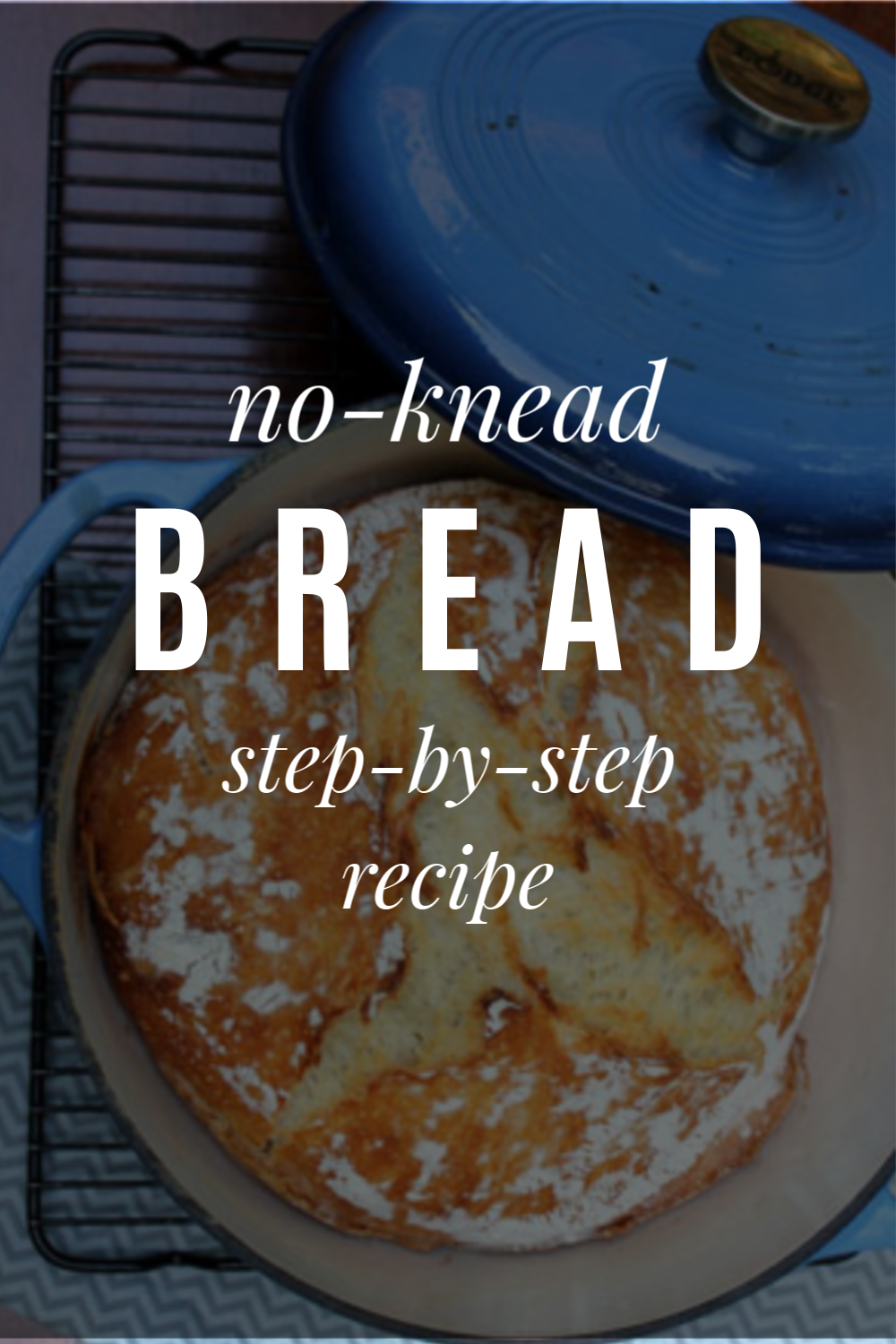
No-Knead Bread Recipe
If you have been hanging out around Frugal Living NW for awhile, you know that I am a big believer in making food from scratch at home. With a few exceptions, I prefer creating something in my own kitchen to buying it in the grocery store.
Bread can be tricky, though. There is some stiff competition out there, and it is tough to replicate a commercial oven’s heat and steam in a normal home kitchen.
For the last several years, I thought that Artisan Bread in 5 Minutes was the best thing since, well, sliced bread. It was simple, and we were content with the results. That is, until last summer when our neighbor brought over a beautiful, delicious loaf of home-baked bread. We had to know her secret. One phone call, and she came back with the book, My Bread by Jim Lahey (Amazon).
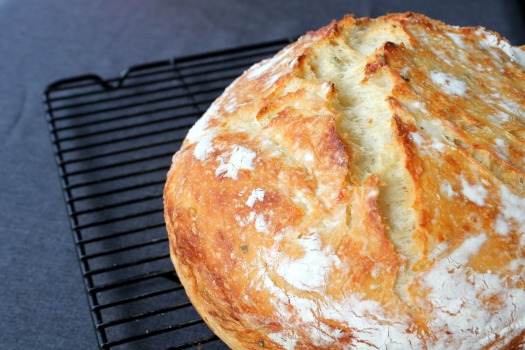
We have been baking bread using this method ever since. I can count on one hand the number of times I have bought bread in the store since then, because I can now make an artisan-quality loaf at home for a fraction of the cost.
I am telling you, this is consistently the best bread I have ever made in my kitchen. Okay, enough gushing. Let’s make some bread.
The only changes I have made to Lahey’s method is to double the amounts and adjust the baking time and temperature to achieve a bigger loaf with a thinner crust.
Oh, and don’t be put off by all these steps. This is totally possible for home bakers at any skill level. I wanted to give you the confidence to do this on your own. A concise recipe can be found at the bottom of this post.
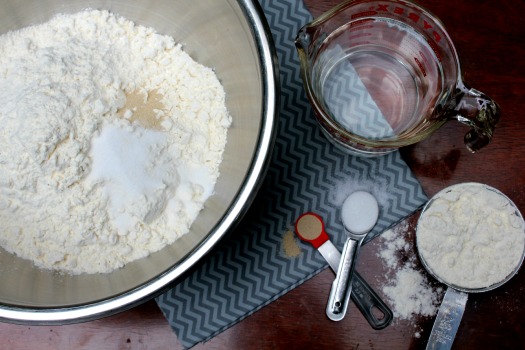
The ingredients are simple: flour, water, salt, and yeast. My husband calculated this bread costs 74¢ per loaf (using Bob’s Red Mill flour & Costco yeast).
Oh, wait! Don’t forget to factor in the roughly 8 cents of energy used to bake it for an hour. No, I’m serious. My husband really does think about this stuff! He’s funny.
So, there you go. A whopping 81¢ for a substantial 2.5 pound loaf of bread. That is crazy cheap.
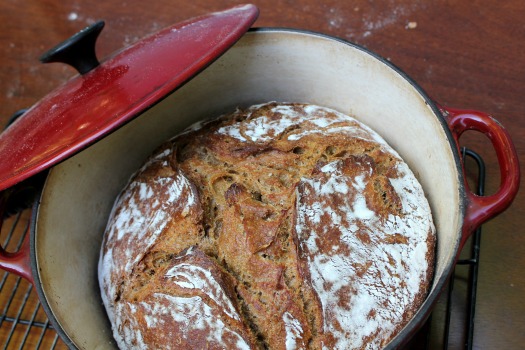
If you want to use some whole wheat flour, substitute 3 cups of whole wheat for 3 cups of the all-purpose flour (3 cups whole wheat and 3 cups of unbleached flour for a total of 6 cups) and add 3 Tablespoons of molasses (optional). This will produce a slightly sweeter, denser loaf of bread. Delicious.
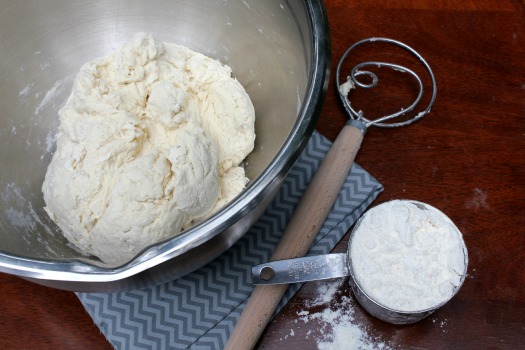
Combine the dry ingredients, add the water, and stir to combine (the funky looking wood-handled item is the amazing Danish Dough Wisk — makes stirring stiff dough a snap). The dough should be wet and sticky. Depending on the temperature and humidity in your home, you may need to add a little more flour or water, 1 Tablespoon at a time. So far, these steps are exactly the same as the 5 Minute method.
The main differences are that you use significantly less yeast (1/2 teaspoon vs. 1 1/2 Tablespoons) and significantly more initial rise time (12-18 hours vs. 2 hours).
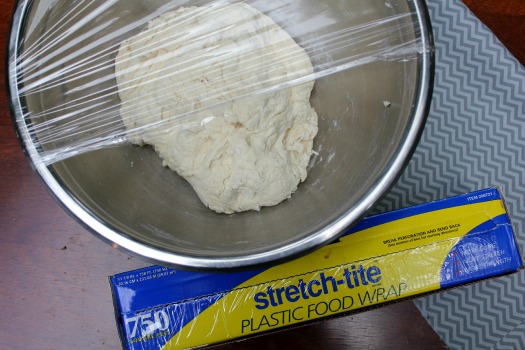
Once the ingredients are completely combined, cover the bowl with plastic wrap and leave it on the counter to rise for 12-18 hours. This slow rise aids in the fermentation of the yeast, giving the bread a better flavor.
Okay, I know what some of you are thinking: 12-18 hours! That’s ridiculous! Who has that kind of time?! I get it.
However, here are two things to consider:
- Once you get into a rhythm of baking your own bread, it’s not a big deal. I start mine in the afternoon or evening and bake it the next morning or afternoon. This would also be an easy weekend routine.
- Just like the title claims, this bread requires no kneading. It is not fussy, temperamental dough. You can produce a delicious loaf of bread with very little hands-on effort & experience.
You’ll know your dough is ready when it has risen in the bowl, smells yeasty, darkened slightly, and is covered with small bubbles.
Using well floured hands, shape and tuck the sticky dough into a rough ball. You can also fold it over a couple times on a well-floured surface. It doesn’t have to be perfect; just keep quickly tucking the dough underneath with your fingertips until you have a semi-smooth dough ball. The dough should be wet but manageable; you don’t want a wet blob so sticky that you can’t shape it into a ball.
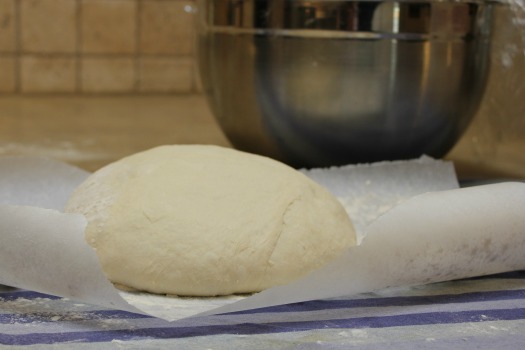
Take a clean linen or cotton tea towel (not terry cloth) and dust it with flour, cornmeal, or wheat germ to prevent the dough from sticking to the towel as it rises. You can also use a floured square of parchment paper on the towel to make the dough ball easier to handle. Place the dough ball, seam side down, in the middle and dust with more flour.
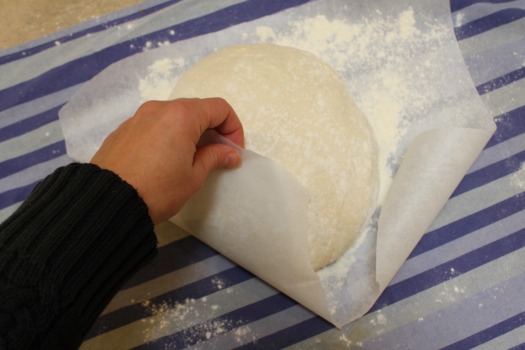
Cover the dough with the (parchment paper and) towel and let it rise for 1-2 hours at room temperature, until doubled in size. During the last 30 minutes of rise time, place a heavy lidded 6-8 quart pot, like a Dutch oven, in a cold oven and preheat it to 425 degrees.
Confession: I own three Dutch Ovens. I use them all the time. They are incredibly versatile and worth the investment. If you don’t own one, you could also make this in any lidded pot, provided it is oven-safe at such high temperatures. Also, check the knob on your pot. If it isn’t rated for such high heat, you’ll want to remove it or cover it with foil. You can also buy an inexpensive replacement knob that is rated for higher temps!
Okay, this is the trickiest part of the entire operation. Remove the lid from the piping hot Dutch Oven, slide your hand underneath the towel or parchment paper, and flip the risen dough (seam side up now) into the pot. Try to flip close to the pot or the flour will fly everywhere. Remove the towel or paper and set aside.
This might take a bit of practice, but again it doesn’t have to be perfect. Some of my worst flips have produced my most beautiful loaves. I love what Lahey writes, “…even the loaves that aren’t what you’d regard as perfect are way better than fine.”
Place the lid back on top and slide the pot back into the hot oven.
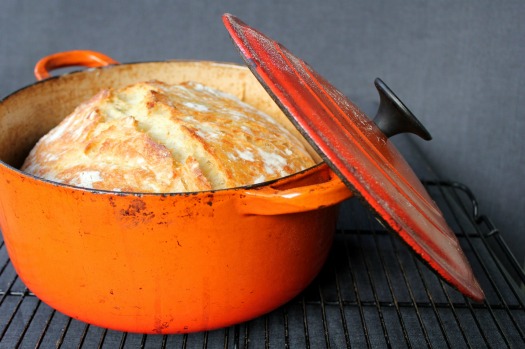
Bake it for 40-50 minutes. Remove the lid. Bake for another 5-10 minutes, until golden chestnut brown. The internal temperature should be around 200 degrees. You can check this with a meat thermometer if you’re nervous about knowing when your loaf is done.
Oh man, your house will smell so good about right now.
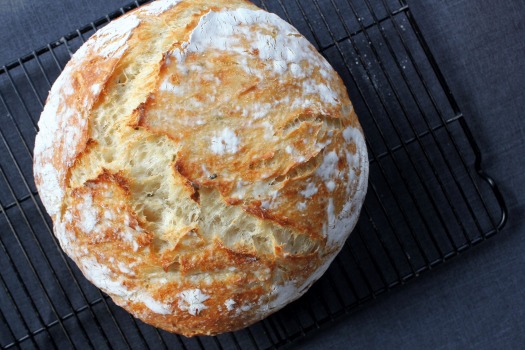
Place the loaf on a cooling rack. You will hear it crackling as it cools. Use every ounce of self-control to resist cutting into it until it is “quiet”; cutting it too soon will make the bread dense and gummy.
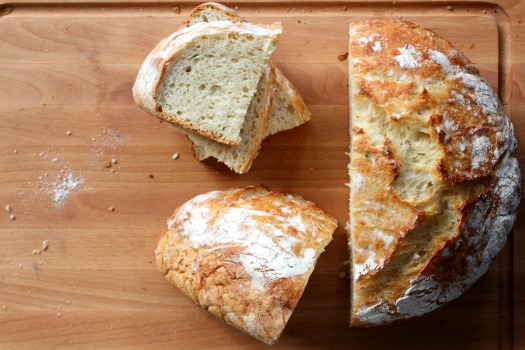
This bread is best the first 2-3 days. I just store my leftover loaf inside the Dutch oven on the countertop. Using plastic wrap will soften the crust. Dry, leftover bread makes great bread crumbs, toast, French toast, or croutons!
Enjoy. And pat yourself on the back. You just baked an amazing loaf of bread!
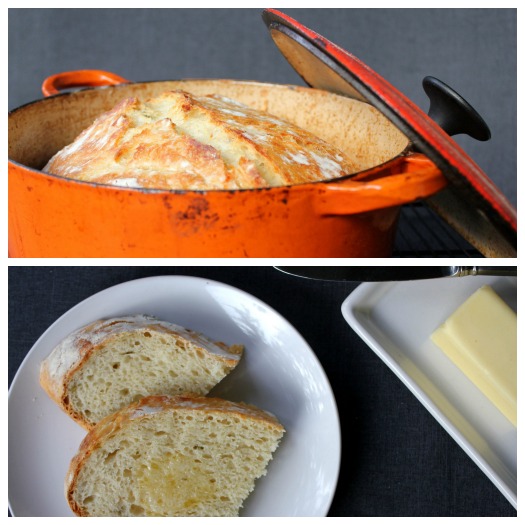
Basic No-Knead Bread
Slightly adapted from Jim Lahey’s My Bread
Ingredients
6 cups bread flour (recommended) or all-purpose flour, plus more for work surface
1/2 t. instant or active-dry yeast
2 1/2 t. salt
2 2/3 c. cool water
- In a large bowl, combine the flour, yeast, and salt. Add the water and stir until all the ingredients are well incorporated; the dough should be wet and sticky. Cover the bowl with plastic wrap. Let the dough rest 12-18 hours on the counter at room temperature. When surface of the risen dough has darkened slightly, smells yeasty, and is dotted with bubbles, it is ready.
- Lightly flour your hands and a work surface. Place dough on work surface and sprinkle with more flour. Fold the dough over on itself once or twice and, using floured fingers, tuck the dough underneath to form a rough ball.
- Place a full sheet/large rectangle of parchment paper on a cotton towel and dust it with enough flour, cornmeal, or wheat bran to prevent the dough from sticking to the parchment paper as it rises; place dough seam side down on the parchment paper and dust with more flour, cornmeal, or wheat bran. Pull the corners of parchment paper around the loaf, wrapping it completely. Do the same with the towel. Let rise for about 2 hours, until it has doubled in size.
- After about 1 1/2 hours, preheat oven to 425 degrees. Place a 6-8 quart heavy covered pot, such as a cast-iron Dutch oven, in the oven as it heats. When the dough has fully risen, carefully remove pot from oven. Unwrap the towel and parchment paper from around the dough and slide your hand under the bottom of the dough ball; flip the dough over into pot, seam side up. Pull the parchment paper off, scraping any stuck dough into the pan. Shake pan once or twice if dough looks unevenly distributed; it will straighten out as it bakes.
- Cover and bake for 40 minutes. Uncover and continue baking for 10-15 more minutes, until the crust is a deep chestnut brown. The internal temperature of the bread should be around 200 degrees. You can check this with a meat thermometer, if desired.
- Remove the bread from the pot and let it cool completely on a wire rack before slicing.
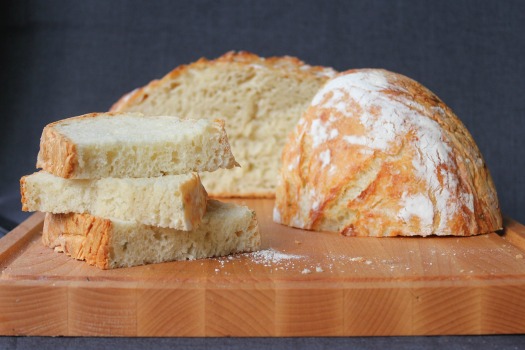
Here are a couple options for Dutch Ovens. Any heavy, lidded 5-8 quart pot (seasoned cast iron or enamel coated) would work with this recipe. Lodge has the best prices/options for dutch ovens on Amazon.
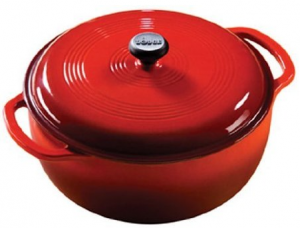
Lodge Logic Dutch Oven in Island Spice Red (6 Quart)
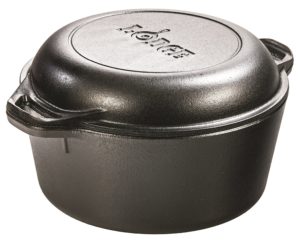
Lodge Cast Iron Double Dutch Oven (5 Quart)
If you already have a dutch oven (or find a deal on a lesser-known brand) that doesn’t have a knob rated for high temps, replace it! There are some really affordable options.
Got questions? You are in good company. Go here for the complete FAQ list.
Looking for more variations to the no-knead bread recipe? We’ve created a list with sweet and savory varieties, including the following:
- Cranberry Orange
- Four Cheese
- Sandwich Bread
- Dark Chocolate Coconut
- Tomato Basil Cheese
- Whole Wheat
Looking for more delicious bread recipes?
Find more delicious recipes on our Recipe Page!
Follow Frugal Living NW on Pinterest!
Fantastic range of boards from best recipes and tips for frugal living to gardening and budgeting help.
This post may contain affiliate links. See the disclosure policy for more information.
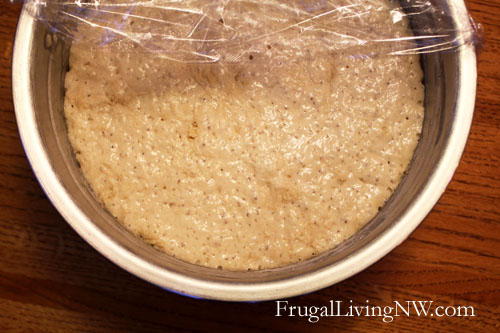
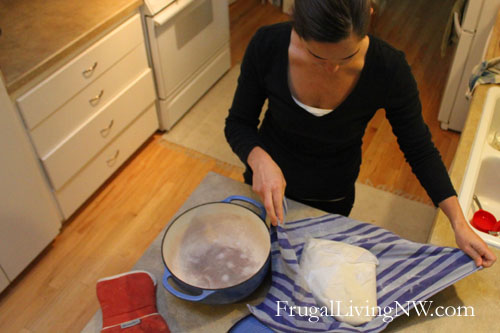
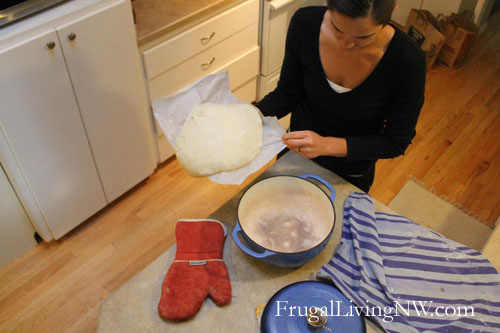

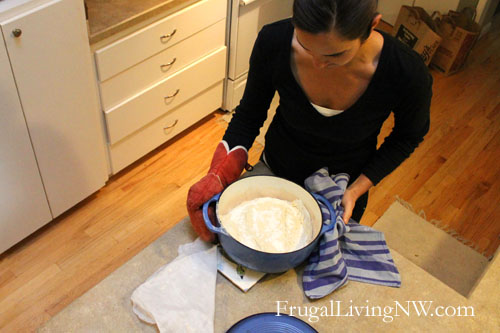


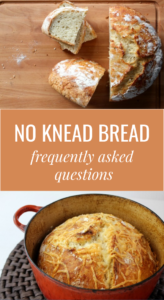
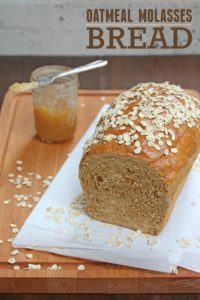
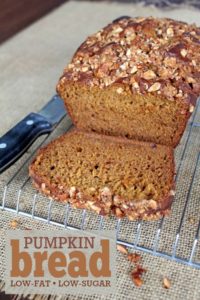
So I have not seen any responses to the gf questions? Is there a blend that you can use to make it gf? Would love to try it, I miss bread soooo much : (
I’ve tried other bread recipes but this was the easiest and BEST one I’ve tried so far! I made it as is (scooped the flour, wasn’t being too precise) and the dough was sticky but I just went with it and it worked fine. I floured the final resting bowl and the dough popped right out into the dutch oven. Hubby LOVES the bread, I can’t wait to try the whole grain and start doing add-ins. THANK YOU!
BTW, I wonder if oiling the first bowl will help the stickiness, or does that change the consistency of the dough, thus the final result?
I can only find fresh yeast here in Spain. Will that work. Google says to use 5 gms to 1 tsp dry. Has anyone tried using fresh yeast? Anything special I should be doing? Can´t wait to try it in a minute…
I don’t have a large pot with a lid, could I use a slow cooker?
I made my first batch using the ceramic shell in the oven and it worked for me.
The most perfect round loaf of bread! It is the easiest bread I have ever made and I thank you for the wonderful recipe.
My dough was very wet and sticky. I added at least another 1cup of flour to just be able to handle or fold the bread. What am i doing wrong? It is resting right now and I haven’t baked it yet, but did I add too much flour? Help!
Hi, Tuti!
The wetness of the dough will depend on the temperature/humidity of your kitchen. It will be slightly different for everyone. I recommend following the recipe as written the first time, then making changes as you get more familiar with the process. However, if your dough is too wet to handle, just add 1-2 T. of flour at a time until you can quickly form it into a rough ball. It should still be a wet, slightly sticky dough. I bet your bread will turn out just fine! It is incredibly forgiving.
Hope that helps! If you have more questions, check out the FAQ page. Happy baking!
It could also be how everyone’s measuring their flour. If the recipe, as written, is assuming a scooped out measuring cup and the next person uses a sift to measure, they’re going to be light on flour. At KAF they say you get 1/8 c more per scooped cup over a sifted cup. (Obviously humidity is a big difference, too- when I was living in Mexico I didn’t need to add water to my pasta recipe it was that drippy wet!!! )
Just out of curiosity, do you scoop or sift to measure?
Good point, Ali_R! That would make a difference. I scoop the flour with one measuring cup, dump it into the other, and level with a knife. And my husband always gives me a hard time for being so precise. 🙂
That’s funny, that’s how I measured and mine was too dry. I added a little more water to make it sticky. I live in Virginia Beach.
SOMEONE HELP! I do not have a dutch oven – or anything other than a metal cooking pan with a lid…… is there anything else I can cook it on? i have posted before and got no feedback. Could I cook it in a bread pan? metal or glass??
My friend made this in a stainless steel pan with a lid and said it turned out as good as in the dutch oven. The only thing you need to be careful with is that the knobs and handles are heat proof at this temperature. Enjoy! This is the best bread I’ve ever made, so versatile and everyone loves it!
I’ve been making it in a stainless steel casserole with a glass lid and it works out perfectly. I cover the handles and lid knob with kitchen foil to ensure they’re safe at such a high temp but the cooking container itself is fine. Go for it!
While perusing a thrift store in search of something to bake in for this particular recipe, I came upon a naked crock pot ceramic shell. I bought it and it produced a great bread. So those with crock pots might want to give it a try. Cheers.
hi, im definitely planning on making this. but im wondering if you think it would work the same if i added in roasted garlic cloves, kalamata olives, or other savory add-ins? anyone tried yet?
thanks and happy baking!
I add rosemary and sunflower seeds; parmesan cheese and 2 T tomatoes paste with basil, ( makes great grilled cheese sandwichees) or garlic and onions. The imagination is your only limit!
Did you add the extras at the very beginning? or carefully folded into dough just before baking? Has anyone else added extras? I’m wanting to do orange zest (maybe sub some marmalade for H20), dried cranberries, & pecan for Thanksgiving.
Gaille,
I always add to the dry ingredients before adding the water to make the dough. Comes out perfect!
P.S. Jalapeno and Asiago was a big hit at our pre-Thanksgiving Thanksgiving on Sunday!
I’m SO excited!! This time of year, think of putting cranberries, oranges and walnuts together… have a quick bread and have done waffles with those flavors. How, I wondered, would this no-knead bread taste? Well, am pleased to report it’s fantabulous!!! 1st off, all extras were mixed in w/ yeast and flour at very beginning. I replaced 3/4 cup of water w/ 3/4 cup “melted” marmalade (fine cut). The marmalade was too warm, so the 3/4 cup water was quite cold from the tap, which brought liquid to room temp. Also added 1 cup chopped walnuts and 1/2 cup dried cranberries. The resulting loaf is chock-full of flavor, but not really sweet – in other words, not like a dessert 🙂 Yes, was concerned about the sugar in marmalade changing outcome, but rising time & rising level of dough were the same. Only thing is the sugar causes crust to brown more rapidly, so be sure and do not bake longer than directed (1/2 hr covered, 15min. uncovered). So far have only tried w/ butter, but will get some cream cheese tomorrow & try that. This is un-sweet enough to be included w/ savory meal as the only bread. My next trial will be with rosemary & roasted garlic.
For Thanksgiving this year, I made this recipe, but I added two bunches of rosemary and 1 1/2 heads of garlic in with the flour and yeast. I didn’t pre-roast the garlic and the recipe turned out amazing. It’s been requested for all future family gatherings in place of regular dinner rolls!
I am very new to baking. I do not have a Dutch Oven, but I do have a very large cast iron pan with a secure lid. Will this work?
Hi, Dani! Any 4-6 qt. heavy-duty lidded pot that is rated for such high heat will work.
What about freezing any leftovers?
And any thoughts on the calorie count?
I’m so excited to try this bread! I just finished mixing it and have it sitting to rise, but, I just realized I won’t be able to touch it again for more like 21 hours.. will this be a problem?
Thanks for the recipe!!
I let mine sit for about that long and it was fine – though I didn’t see the bubbles that are shown in the above picture but i went ahead and it turned out great.
It worked!! Even in high altitude Colorado!! Thank you so much for the inspiration!
I have made bread before, but never so easily or with such delicious results! WOW! I think a Dutch oven with this recipe would be one of the best house-warming, birthday, wedding, holiday, etc. gift ever!
I started the dough last night and finished it today. I have only mad bread once before years ago and it was not so good. This bread was so easy and is just amazingly good! Love the crunchy crust! I will make this again and again!
Oh my gosh, I made this today and it was delicious! I’d never baked bread before and I’m not much of a baker in general, but this was delicious. Nothing better than warm, homemade bread! My dough was really sticky the entire time but it still came out wonderfully.
While camping, if you like to cook and bake outside in a dutch oven with coals, this recipe works fine, just be sure to preheat the dutch oven. If it is very cold, you may need to help the bread rise, by putting 2 or 3 coals on the dutch oven while it is rising.
I hope you got permission from Mr. Lahey and his publisher to use his recipe on your website.
Another Emily – Get a grip and enjoy the recipe…
The recipe has been adapted from his and you are allowed to use a recipe as long as you give credit to the original source.
I`ve made bread the old way and sometimes when it`s not as warm out as i like i have turned the oven on low 125 and let it warm up then shut it off , then put my dough in just like you would on the counter. and it takes half the time to rise. i don’t know if it would make a difference with this recipe.
Hello,
I just wanted to say thank you so much for posting this. I have wanted to make this exact bread for a long time however haven’t been able to find one as EASY
as this one (sorry I hit the wrong key). My daughter (3yr) helped me and I love getting her involved when I can. Thanks again.
My cousin is severely gluten allergic. She has posted experiments in cooking, with her hubby as test subject. She’s in the UK but I’ve seen her ingredients on amazon, though I’ve not tried any. Look here: http://blissglutenfree.blogspot.com/
I made this bread tonight and it turned out awesome!!! I actually made two batches, the first one I followed the recipe exactly. With this batch I thought that it would be too dry, but left it as the recipe instructs. The second batch I added 2/3 of a cup to the dough to see if it would make a difference. Both turned out amazing! The second batch came out a little lighter in texture and colour. So happy I tried this recipe!!
This bread is delicious and so easy to make. Can this bread be frozen?
Hi there,
Found you via Pinterest. Just letting you know I posted a picture of bread made using your recipe on Facebook, and on the CA Olive Ranch olive oil page – and it’s caused a ruckus! Everyone wanted the recipe, so I’ve pointed them here. Thanks for sharing this awesome bread!! My wallet, my pregnant belly, and my family thanks you! 🙂 https://www.facebook.com/CaliforniaOliveRanch?fref=ts
Wow! Thanks for the link love, Jessica!
I’ve made this twice in the past three weeks. My dough is really gooey and hard to handle. No matter how much flour I put on the towel, after two hours of resting it sticks. Badly. The second time, I lined the towel with parchment heavily dusted with flour. Stick city. I’ve been baking bread for 30 years and never run into this problem. There has to be a better way. Suggestions?
My dough is really sticky too 🙁 I don’t know what I’m doing wrong. Its sticky after the 12-18 hrs and after the rising in the towel. Any suggestions out there? Does anyone ever use more yeast, use warm water or proof the yeast?
Thanks
Hi, Beth M & Melissa – That’s strange that it’s giving you trouble. Don’t give up!! 🙂
If your dough is super sticky, feel free to add 1 T. of flour at a time to the dough. It is supposed to be a wet dough, but you should be able to handle it and form it into a rough ball on the floured towel. I am now using a square of parchment paper on the towel. I still dust the parchment paper with enough flour that the dough doesn’t stick. Even if it does stick, just flip it into the pot and scrape the sticky dough on top. It might look strange going into the oven, but it should still bake up nicely. Hope that helps!
Mine is sticky as well but it comes out tasting great. I’ll try adding more four to see if that helps. I wonder if it’s living in the damp pacific nw?
Bread dough reflects the amount of moisture in the flour you’re using; if your dough is sticky, use more flour–a little at a time–until it feels (or looks) like the photos posted. If your area is very humid, you’ll need more flour than where relative humidity is looooooooooooooooow.
I substituted 1 cup sour dough starter for: 1 cup bread flour, the yeast, and ~1/2 cup water. It worked really, really well. Thanks for this great recipe.
Nancy, or anyone out there… I do want to try this as sour dough. I’ve never made bread (until this recipe) so I’m scared to try sour dough. No yeast is used with sour dough starter? Sounds like I just buy that and make a few adjustments and I’ll have sour dough? Yum!
Should the Dutch oven be oiled? I make other bread in my Dutch oven, and I always oil it. Thanks!
Hi, Pat! Because of the high heat, it doesn’t need to be oiled, but I don’t think it would make a big difference if you want to do it.
Are there any special high altitude directions? I live in Colorado Springs so our elevation is about 6500 ft.
Nope, I am right there with ya and I didn’t change basic recipe for the altitude. Works great.
Hi Lisa,
I am a professional baker and what you are experiencing is the gluten in the bread. By letting this rise for over 12 hours, it is letting the gluten develop on its own, hence not needing and kneading. What you are perceiving as rubbery is actually just the texture of the proteins in gluten when fully developed.
Courtney:
Can u recommend a flour that I may be able to use for this? Because of allergies, I cannot even use glueten free flour so I’ve been using coconut flour, tapioca flour, or garbanzo bean flour. I havent made the bread yet, but im wondering will it rise just the same or even at alk
I just made this for the first time and I have never made bread before. It was very good but the texture seemed a little rubbery. I let it cool almost completely, so what do you think happened. Is this the was it is suppose to be? Or did I do something wrong? I did exactly what the recipe said and then I let it rise for 13 hours. Then folded it under, wrapped it and let it sit for another 1 1/2 hrs then baked it on 430 for 50 min plus 10 uncovered.
Hi there! Love love love this recipe and am excited to try it tonight. A question— will it get beautifully golden all by itself, with no egg-wash required? I’m had breads bake really well in the past but just not get golden (sort of stayed a pasty death-white. haha) Help! 🙂
Hi, Anna – There are no hidden steps or trick photography here, I promise! 🙂 I make my bread exactly as written and it turns out exactly as photographed. Leave a comment and let us know how it goes!
It stayed white because you baked it outside of a dutch oven. Try the dutch oven, it’s the secret to great looking home baked bread.
Oh my God! I did it! It’s sitting on my counter crackling right now. It’s beautiful! Besides my kids, it’s the prettiest thing I’ve ever made! First time making bread, followed the directions to a T, when i pulled it out of the oven and stuck in my thermometer–DING! 200 Degrees! It’s like everything is right in the world… I will try not to eat it until dinner tonight, with pasta, wherein my family will gaze upon me adoringly and say, “Mom, you’re the best!” Thanks for the recipe. Apparently, I am now a bread-baker. 🙂
Well, it’s four weeks now since I first made this bread – see my comment September 26th. I loved it then, now I just adore this recipe and how versatile it is! We had guests for dinner and they ate it all!! I’ve used it for pizza. I’ve added raisins and spices for fruit bread. I’ve added sunflower seeds, pumpkin seeds, walnuts. Every bread is delicious. The bread lasts a few days and is still fresh to the last slice – it might last longer but not in our house! It toasts well and last night my husband made french toast. I can’t recommend your recipe enough and have shared it with quite a few people. How can I say thank you enough? Thank you thank you thank you 🙂
How did you use it for pizza?
I made this bread overnight – next time, I’ll start at night and finish in the daytime! 🙂 I made it exactly as the recipe called for. Had to get my husband to help me mix it to the wet dough because of my arthritis, and he got it mixed really well. It did not stick to the towel – I made a big old mess with the flour! It is huge, popped right out of our Dutch Oven (Lodge cast iron). It went perfectly, even though it was a little cool in the house (upper 60s). We managed to let it cool before slicing. It is absolutely delicious – we love the chewy texture, and the crust is wonderfully crunchy. It’s now wrapped in a towel on the counter, and it’s about all I can do to stay out of the kitchen! Thanks, and I’m passing this on!
I made this twice now and it tastes amazing!!! However both times I had a problem with it sticking to my dutch oven… but I have to admit I overread the part about preheating the duch oven with the oven and I think I added too much water this last time.
How AMAZING though!!! I will bake my own breads from now on!!!
THANK YOU
Thank you so much for this post. I’m very excited to try it. However, being in the UK, I’m struggling to find a pot big enough, which can be heated above 180deg! It’s virtually impossible to find a Dutch oven and those I have found are ridiculously expensive. So I was thinking about halving the recipe but have no idea how long it would need to bake for. Any thoughts would be very very welcome! Thanks.
Sure, just cut the amounts in half, follow the directions as written, and bake at 425 for 30 min. covered and 10-20 min. uncovered (until internal temp of 200 and golden brown crust). Hope you are successful in tracking down a pot that will work!
Emily, thanks so much for your swift reply. Apologies though, I just saw you answered a similar question on 6th October but there are so many comments that I hadn’t read them all! Anyway, that’s very helpful and I’m going to attempt it with a Pyrex dish and lid, I think, or I may zip to TK Maxx to try and get a cheap casserole now I know I can get a smaller one. Anyhoo, very excited to try it!
Hi Emily,
The bread making has been going extremely well, thanks so much for your post and tips. I purchased a stainless steel casserole and have since tried a half batch, full batch and 3/4 batch! The 3/4 recipe seems to work best for me in my casserole. Unfortunately I’ve hit a snag the last 3 times I’ve made the bread. I think it’s something to do with the casserole. The bread has stuck solidly to the dish at the bottom and sometimes on the sides too. It didn’t happen the first few times I made the bread so I’m wondering if it’s something that’s changed since washing the dish several times. Is there anything I can do to stop the sticking without compromising the makeup of the bread? Can I spray with oil? Line with parchment? What would you recommend. It’s so depressing as the bread turns out wonderfully but I have to stab, jab and poke the sides and bottom to get it out and generally the bottom crust is left stuck to the pan. *sigh* Help!
Hi, Morgan —
That is frustrating. I’ve had it happen a couple times so I totally get it. I’m wondering if it’s your pot, though, since it’s happening so often?
Here are my suggestions:
1) Make sure you are preheating the pot for the full 30+ minutes.
2) Lightly oil the pot or do the 2nd rise on a square of parchment paper and, instead of flipping the dough into the pot, just lift and place the dough in with the parchment paper on the bottom.
Hope this helps!
It must be the pot, can’t think why else it would suddenly be doing it when nothing else has changed. I had been heating the pot for at least 30 mins until this last time when I tried putting it in cold to see if that would make a difference (it did, actually stuck slightly less!) Thanks for the suggestions. I already do the second rise on parchment so will just place the dough and parchment in the pot together and see how that goes. I do have to say that my dough looks nothing like yours though! Yours is nice and…er…handle-able! Mine is soooo sticky that I have to peel it out of the bowl, peel it off my hands and onto the parchment. I can’t even mould it or turn it over or anything. I’m lucky if I can pass it from one hand to the other a couple of times. It doesn’t sit nicely in a ball ready to rise, it just is a gelatinous pile of gloop. And when putting into the pot it just hangs off the parchment until I painstakingly peel it off! And yet it still turns out wonderfully and tasty! It’s pretty much a foolproof, failure-proof recipe! All the comments are testament to how fabulous it is. So I just want to say a huge thank you for posting and for taking the time to respond to posts.
Ok, so…yeast scares me, never made bread but thought I’d give this a go. Forgot to mix dry ingredients before adding water. Due to family tragedy, dough sat out for 24 hours. By the time I got around to baking it I was so tired that I only let it rest for 11/4 hours. Only had pyrex to bake it in and only had oven to 425. All that and it still came out great. Cooling on rack now. 1 plain, 1 cinnamon raisin. Smells great, can’t wait to try. Apparently, you can not kill this bread!
Ha! Your comment made me laugh out loud. Good to know that this bread can take a beating and still work.
Do you need to oil or spray the dutch oven?
Nope! Just preheat the pot in the oven as written. It will create a crust on the bread, and the loaf should pop right out when finished baking.
How much should the dough have risen after 12 hours? My grandma baked THE best bread, and I’ve always been afraid to try bread, because I knew it could never compare (just like Das’s fried chicken and potato salad). So I really want this to work, just so
I know that I CAN make bread, even if it’s not the same as Grandma’s.
It’ll depend on how warm your room is. I mixed together a batch yesterday afternoon, let it rise all night (18 hours), and baked it this morning. My house was around 67 degrees and the dough didn’t rise as much as in the summertime, but the loaf still turned out great. I like letting it rise for the longer time, but I usually just check the dough around 14 hours to see that it is covered with bubbles, smells yeasty, has risen, and darked slightly. Follow the directions as written and you should be pulling beautiful loaves of bread out of your oven on a regular basis!
I just took it out of the oven. It alone could be dinner tonight. It’s gorgeous! I don’t have a cast iron Dutch Oven so I used a hand thrown ceramic bowl covered with foil and topped with a cookie sheet. My dough stuck to the towel. Next time, I’ll heavily flour the towel. Thank you so much for this recipe. It’s going to be my new favorite!
Way to be creative! Love your solution and glad it worked out well. I’ve started using parchment paper on top of the towel, then lightly dusting the paper. That way it doesn’t stick and I don’t have to use as much flour. Hope that helps!
I’m so bummed– my dough didn’t rise at all, and I wasted a bunch of bread flour! I followed the recipe exactly. I did comment to my husband, however, that the dough did not look wet and sticky in the beginning. Should I have added more water?
I’m not the writer of this blog, but I thought I’d jump in. I’ve made this a couple of times now and both have turned out wonderful. I followed the recipe exactly. I read other comments of people adding water, but I didn’t. I did stir a LOT in the first step to incorporate all the ingredients. I kept stirring and stirring and finally everything came together.
Is your yeast fresh and your room around 65-70 degrees? Each batch is slightly different. If the dough seems too dry to you, you can add water 1 tablespoon at a time. You don’t want it so wet and sticky that you can’t handle it or form it into a rough ball.
I have been baking bread for years and just tried this recipe the other day, it came out perfect!! My only problem was the high temp caused my Dutch Oven to smoke a bit in the heat up stage. I wonder if you have had this problem. I give my oven a thin coat of fresh oil after every time it is used. I also thought the water content a little low, I am going to add in 1 Cup of Sourdough starter to today’s without changing anything else, will let you know how that goes.